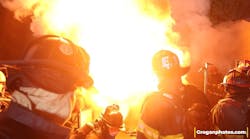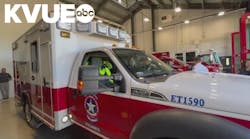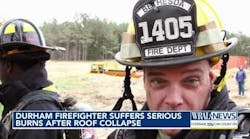On Saturday, Dec. 13, 2008, a three-alarm fire destroyed the Comfort Inn hotel in East Franklin Township, PA. The three-story hotel was built in 1995 with a steel and block superstructure and a wood and shingle roof. The building was 100 feet by 250 feet. Smoke detectors were on all three floors and each of the guest rooms. Standpipes in both stairwells were fed by 2½-inch risers from the municipal water system. Fire department connections were on each floor, but there were no hose racks. There was no fire detection or suppression system in the attic. The hotel contained 70 guest rooms. At the time of the fire, 24 guests were staying at the hotel.
At 2:25 P.M., a first-alarm assignment was dispatched by Armstrong County 911 for a structure fire at the hotel, at 13 Hilltop Plaza. Responding on the alarm were East Franklin Township Volunteer Fire Department Engine 62, a 1,500-gpm pumper, and Heavy Rescue 65; Applewold Volunteer Fire Department Engine 10, a 1,000-gpm pumper; West Kittanning Volunteer Fire Department Engine 244, a 2,000-gpm pumper, and Rescue 243; Kittanning Hose Company Number One Engine 110, a 1,500-gpm pumper, and Ladder 110, a 100-foot aerial ladder; and Worthington & West Franklin Township Volunteer Fire Department Engine 251, a 1,500-gpm pumper. East Franklin Township Fire Chief Mark Feeney arrived on scene at 2:27 and observed heavy smoke coming from the eaves of the building.
Upon arrival, there was reported entrapment in Room 320 on the third floor. The individuals initially exited the building when the fire alarm sounded, but when they saw the smoke, they returned to their room to get their belongings. Other guests and employees left the building when the alarms sounded. First-in search crews did not get key cards to open doors and the hotel guest register was left in the building by the staff. With a little delay, the search crew retrieved the key cards and guest register from the building. Feeney requested that all 70 rooms be cleared by crews and to double-check all rooms on the third floor.
Initial Operations
Engine 62 arrived on scene at 2:37 P.M. and was positioned in front of the building (A side). Firefighters advanced two 200-foot, two-inch attack lines into the building through a third-floor window using a 35-foot extension ladder and the stairwell. Engine 244 laid a 350-foot, five-inch line to the front of the building and supplied Engine 62 with a 75-foot, five-inch line. Firefighters also placed a 200-foot, two-inch attack line and a 200-foot, 2½-inch attack line into operation from the pool roof from Engine 244. These lines were eventually advanced to the third floor. Engine 110 was positioned on side D to support Ladder 110.
Manpower from this engine was assigned to third-floor search crews. According to the pre-plan, Ladder 110 was positioned on side D, where a lumber yard was located 80 feet from the fire building. This ladder was set up to prevent fire extension to the lumber yard and for possible aerial master stream operations on the hotel. Engine 10 laid a 500-foot, five-inch line to side D and supplied Ladder 110 with a 100-foot, five-inch line. Rescues 65 and 243 were positioned on side D and set up for support, lighting and a rapid intervention team.
Feeney requested a second alarm at 2:29 P.M. Responding were Kittanning Township Engine 310, a 1,250-gpm pumper, and Heavy Rescue 310; Manor Township Volunteer Fire Department Engine 160, a 1,500-gpm pumper, and Quint 160, a 75-foot Squrt with a 1,750-gpm pump; Freeport Volunteer Fire Department Engine 70, a 1,500-gpm pumper; Kittanning Hose Company Number Six Tower 131, a 75-foot tower ladder with a 1,750-gpm pump, and Ambulance 130; Kittanning Hose Company Number Four Air Truck 121; Oklahoma Volunteer Fire Department Air Truck 49; and Ford City Hose Company Number One Ambulance 90.
Tower 131 was positioned at the center of the building on side A and fed with a 400-foot, five-inch supply line from Engine 244. Due to low water pressure from Engine 244, an additional 700-foot, five-inch line was laid by Engine 164 from a hydrant in the shopping center. Tower 131 was set up for possible aerial master stream operations. Rescue 310 was staged to handle any additional calls. All second-alarm manpower was assigned to third-floor operations.
Roof Failure
At 2:52 P.M., portions of the roof began to fail. The 14 firefighters manning the four interior lines were ordered to evacuate the building. After a personnel accountability report (PAR) was taken, a defensive attack was initiated from Tower 131 with two 750-gpm master streams from the bucket. After 20 minutes, the master streams were shut down and crews reassembled to continue interior operations.
Due to low water pressure on the hydrants, Feeney requested a third alarm at 3:09 P.M. for tankers to be used as an alternate water supply. Nineteen tankers were requested from three counties. Responding were East Franklin Township Tanker 60, a 1,500-gallon tanker with a 1,000-gpm pump; South Buffalo Township Volunteer Fire Department Tanker 221, a 2,500-gallon tanker with a 1,500-gpm pump; Sugar Creek Volunteer Fire Department Tanker 230, a 2,000-gallon tanker with a 1,000-gpm pump; Distance Volunteer Fire Department Tanker 300, a 1,500-gallon tanker with a 1,000-gpm pump; Washington Township Volunteer Fire Department Tanker 280, a 2,500-gallon tanker with a 750-gpm pump; Dayton Volunteer Fire Department Tanker 30, a 2,000-gallon tanker; Kittanning Township Tanker 310, a 2,500-gallon tanker with a 1,500-gpm pump; Gilpin Township Volunteer Fire Department Tanker 100, a 2,500-gallon tanker with a 1,500-gpm pump; Kiski Township Volunteer Fire Department Tanker 140, a 3,000-gallon tanker with a 1,500-gpm pump; Bethel Township Volunteer Fire Department Tanker 270, a 1,500-gallon tanker with a 1,000-gpm pump; Parks Township Volunteer Fire Department Tanker 200, a 2,000-gallon tanker with a 1,000-gpm pump; Pine Township/Templeton Volunteer Fire Department Tanker 190, a 2,000-gallon tanker; Elderton Volunteer Fire Department Tanker 50, a 1,500-gallon tanker; Rayburn Township Volunteer Fire Department Tanker 260, a 2,500-gallon tanker with a 1,500-gpm pump; Worthington & West Franklin Tanker 250, a 2,500-gallon tanker with a 1,500-gpm pump; a Lick Hill Volunteer Fire Department 3,000-gallon tanker; and an East Butler Volunteer Fire Department 3,000-gallon tanker. Engines 251 and 162 were set up to draft out of four portable tanks to supply water to the fireground. A tanker fill site was established four miles away on another municipal water system so as not to affect the water supply being used on the fireground. The tankers did not have to be used as the fire was knocked down and the municipal water supply was sufficient for overhaul operations.
After the aerial master streams were shut down, interior operations resumed. In addition to the four handlines already in place, Ladder 111 supplied a 150-foot, three-inch line that was wyed into two 100-foot, 1¾-inch handlines. Twenty-six firefighters were now assigned to the interior operations on the third floor.
Under Control
Feeney declared the fire under control at 5 P.M. and began releasing mutual aid companies. Everything on the third floor in the fire area, approximately 20 rooms, was dumped out the windows and hosed down due to small pockets of fire in the beds and furniture. A large amount of insulation was shoveled out to prevent rekindles.
Investigators from East Franklin Fire Department; Pennsylvania State Police Fire Marshal's Office and private insurers conducted a four-day, on-scene investigation. The fire originated in the bathroom ceiling area of Room 322. It was determined that it was electrical in nature, being a 110-volt feed to the electric fan/light in the bathroom. Damage was estimated at over $4.5 million. The third floor and roof were total losses with the first and second floors suffering 75% loss.
Lessons Learned
Pre-plans and on-site drills at the hotel conducted with all first-alarm departments enabled firefighters to be familiar with its structure and layout. Also, the departments have responded to many smoke alarms and small fires here over the years. A search crew has been added to the pre-plan as the search efforts required eight of the first-arriving firefighters. Accountability of firefighters in the large structure was a concern as firefighters would often enter through one entrance and exit the building from another. Officers from mutual aid departments were assigned at each entrance and notified command of crew locations.
The day after the fire, the department held a walk-through of the building to let firefighters assigned to outside operations see the inside and the extent of the damage. The department used the building for training purposes before it was demolished and rebuilt.
JAY K. BRADISH/IFPA, Firehouse® news editor, is a former captain in the Bradford Township, PA, Fire Department. He has been a volunteer firefighter and fire photographer for more than 25 years.





